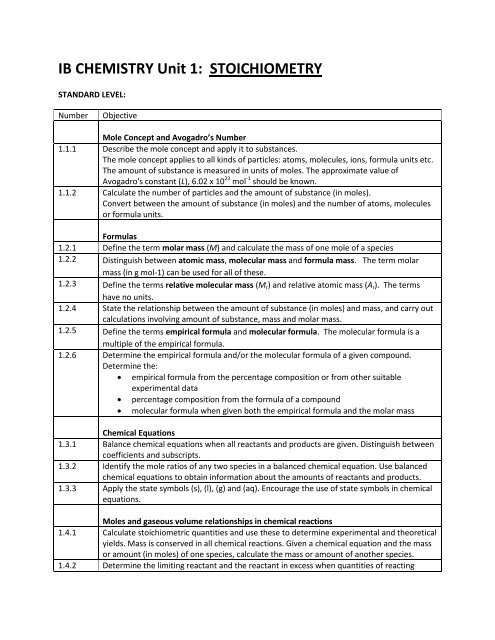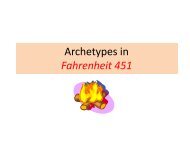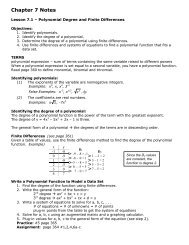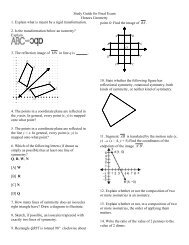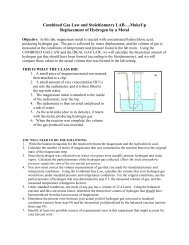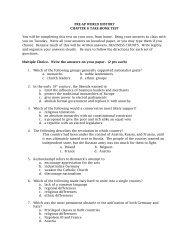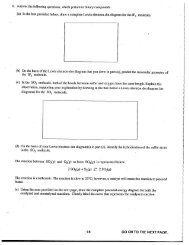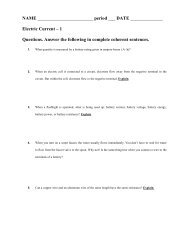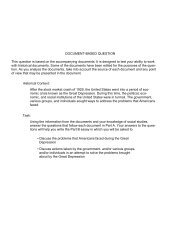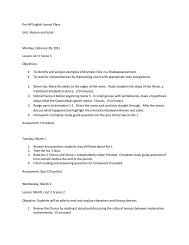Create successful ePaper yourself
Turn your PDF publications into a flip-book with our unique Google optimized e-Paper software.
<strong>IB</strong> <strong>CHEMISTRY</strong> <strong>Unit</strong> 1: <strong>STOICHIOMETRY</strong>STANDARD LEVEL:NumberObjectiveMole Concept and Avogadro’s Number1.1.1 Describe the mole concept and apply it to substances.The mole concept applies to all kinds of particles: atoms, molecules, ions, formula units etc.The amount of substance is measured in units of moles. The approximate value ofAvogadro's constant (L), 6.02 x 10 23 mol -1 should be known.1.1.2 Calculate the number of particles and the amount of substance (in moles).Convert between the amount of substance (in moles) and the number of atoms, moleculesor formula units.Formulas1.2.1 Define the term molar mass (M) and calculate the mass of one mole of a species1.2.2 Distinguish between atomic mass, molecular mass and formula mass. The term molarmass (in g mol-1) can be used for all of these.1.2.3 Define the terms relative molecular mass (M r ) and relative atomic mass (A r ). The termshave no units.1.2.4 State the relationship between the amount of substance (in moles) and mass, and carry outcalculations involving amount of substance, mass and molar mass.1.2.5 Define the terms empirical formula and molecular formula. The molecular formula is amultiple of the empirical formula.1.2.6 Determine the empirical formula and/or the molecular formula of a given compound.Determine the: empirical formula from the percentage composition or from other suitableexperimental data percentage composition from the formula of a compound molecular formula when given both the empirical formula and the molar massChemical Equations1.3.1 Balance chemical equations when all reactants and products are given. Distinguish betweencoefficients and subscripts.1.3.2 Identify the mole ratios of any two species in a balanced chemical equation. Use balancedchemical equations to obtain information about the amounts of reactants and products.1.3.3 Apply the state symbols (s), (l), (g) and (aq). Encourage the use of state symbols in chemicalequations.Moles and gaseous volume relationships in chemical reactions1.4.1 Calculate stoichiometric quantities and use these to determine experimental and theoreticalyields. Mass is conserved in all chemical reactions. Given a chemical equation and the massor amount (in moles) of one species, calculate the mass or amount of another species.1.4.2 Determine the limiting reactant and the reactant in excess when quantities of reacting
substances are given. Given a chemical equation and the initial amounts of two or morereactants: identify the limiting reactant calculate the theoretical yield of a product calculate the amount(s) of the reactant(s) in excess remaining after the reaction iscomplete.1.4.3 Apply Avogadro's law to calculate reacting volumes of gases.Solutions1.5.1 Define the terms solute, solvent, solution and concentration (g/dm -3 andmol/dm -3 ). Concentration in mol dm-3 is often represented by square brackets around thesubstance under consideration, ex [CH 3 COOH].1.5.2 Carry out calculations involving concentration, amount of solute and volume of solution.1.5.3 Solve solution stoichiometry problems. Given the quantity of one species in a chemicalreaction in solution (in grams, moles or in terms of concentration), determine the quantityof another species.


